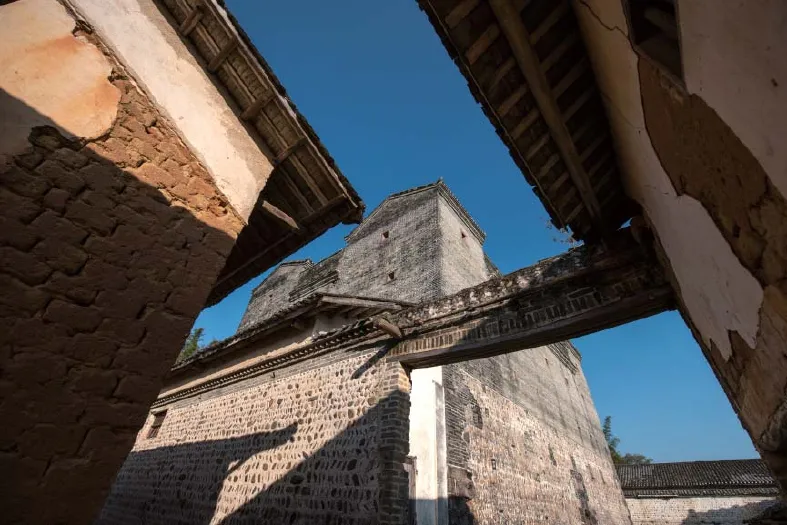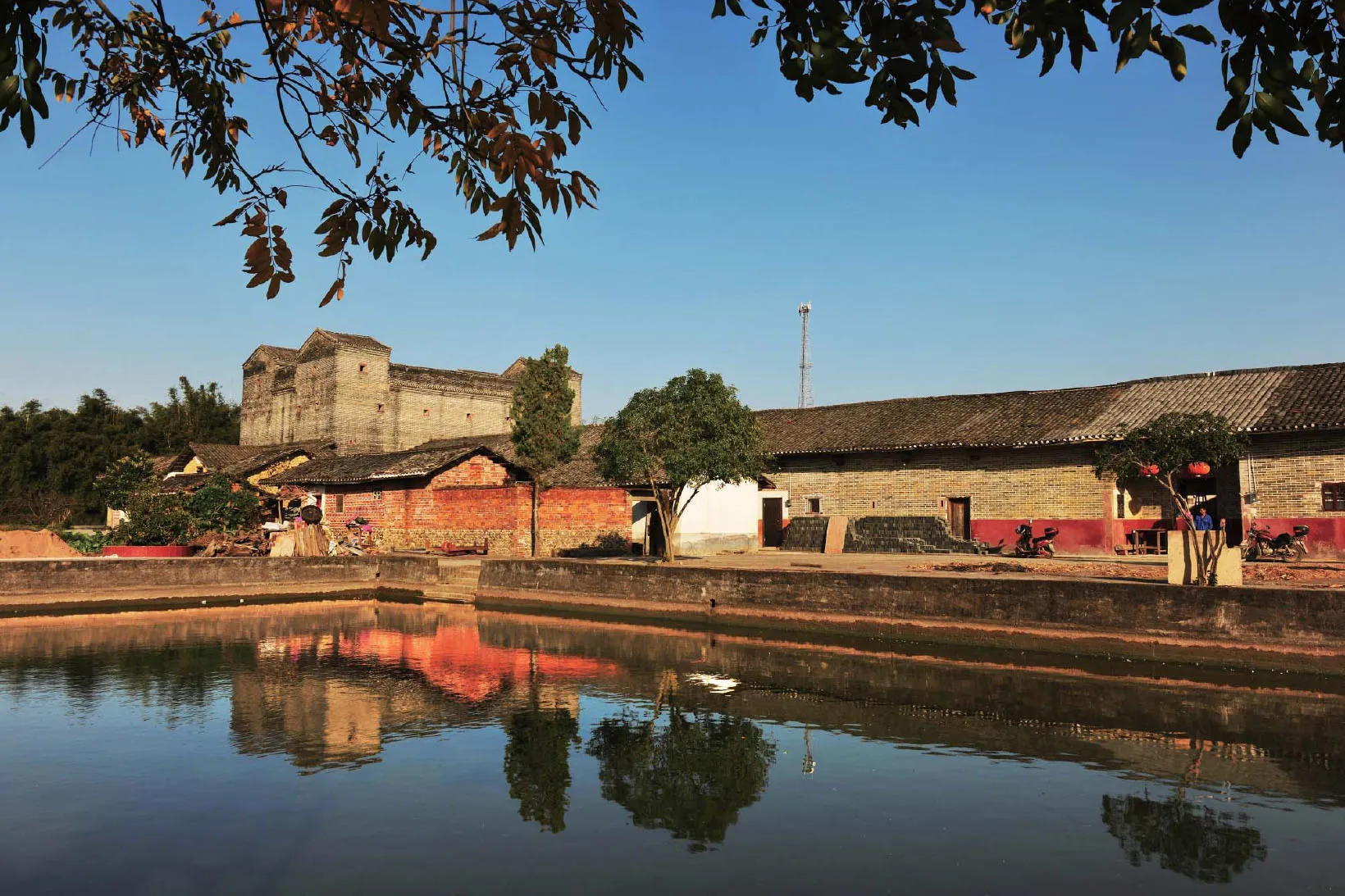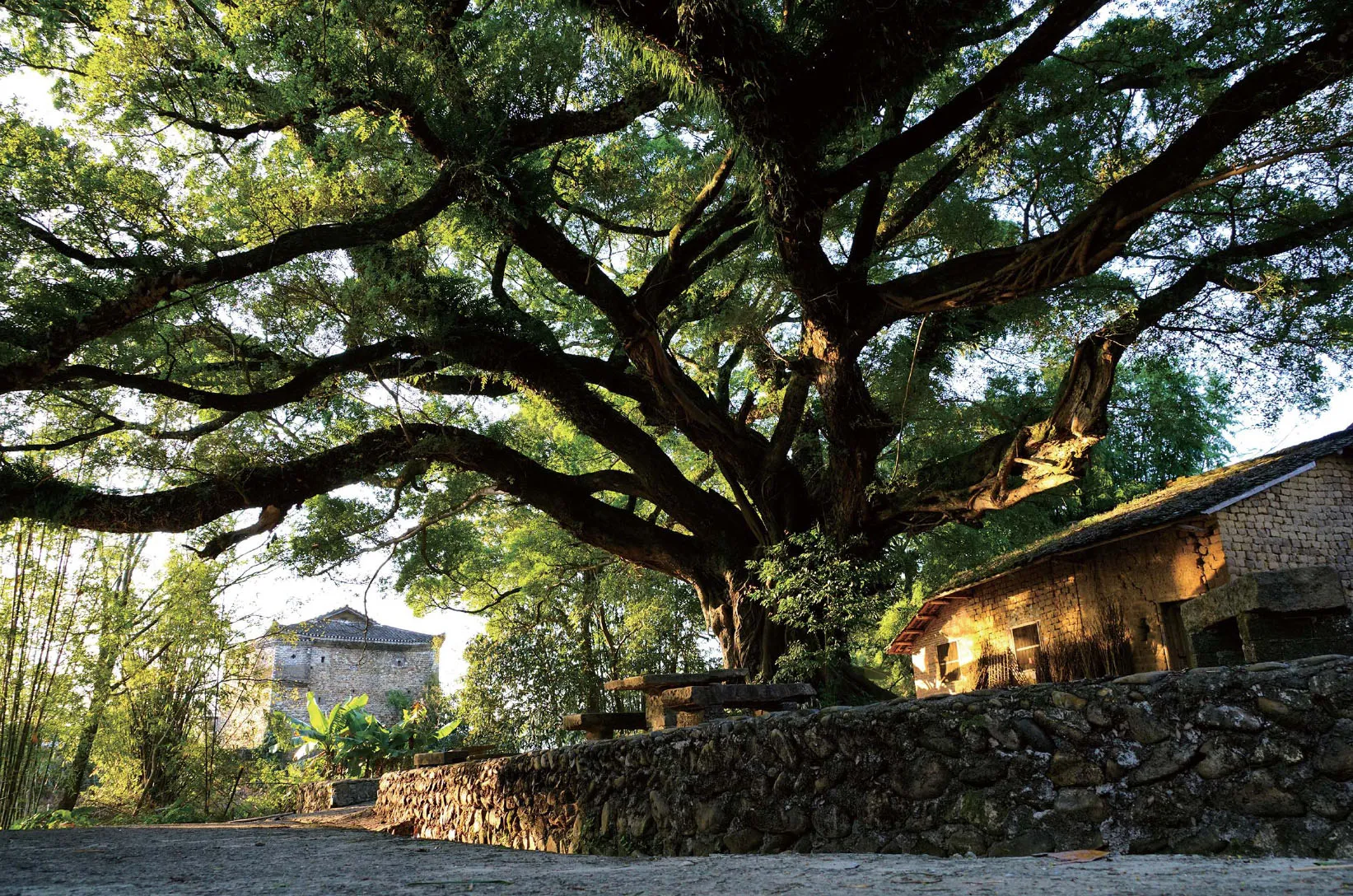到粤北第一古郡看“古堡”
2017-07-05刘照丁LiuZhaoding曹宇光CaoYuguang
文刘照丁 Liu Zhaoding 译曹宇光Cao Yuguang
到粤北第一古郡看“古堡”
Chinese “Ancient Castles”at the Eldest County in North Guangdong
文刘照丁 Liu Zhaoding 译曹宇光Cao Yuguang
中国广东省始兴县置县于三国吴永安六年(公元263年),距今有1750多年的历史,是粤北第一古郡。在这片2174平方公里的大地上,至今耸立着249座客家“围楼”。有人说,这些“围楼”与福建“土楼”、广东开平“碉楼”一起,堪称中国式“古堡”奇观。由此,这个千年古县也被称为“中国围楼之乡”。
说起“古堡”,许多人自然会想到欧洲的城堡。欧洲城堡的鼎盛时期是公元1066年至1400年,是贵族为争夺土地、粮食、牲畜、人口不断爆发战争而修建的,它以神秘、财富、复仇、浪漫爱情等关键词填充其故事内涵,吸引不少人前往探究其奥秘。
其实,类似“古堡”式的建筑在中国并不鲜见,公元641 年松赞干布为迎娶唐朝文成公主,在中国西藏拉萨建造的布达拉宫,就是世界上海拔最高的“古堡”。还有分布在中国东南部福建、江西、广东客家地区,始建于公元769年的土楼,也可称作是中国式“古堡”建筑的代表,已被联合国教科文组织列入世界文化遗产名录。
欧洲“古堡”和中国式“古堡”之所以称为“堡”,是之于两个共同的特征,即建筑坚固和利于防御。正所谓“堡”者,堡垒也。不同之处是建造材质和外表形式,还有就是用途的变异。欧洲“古堡”的城墙大部分是柱石建筑,外表有“古典柱式”“罗马式”等,用途上既为防御,也用于扩张领土,使用者皆为上层贵族。而中国式“古堡”的建材则强调就地取材,由土、石、砖、木融合建造,用途上主要是防御,此外还用于居民生活,使用者既有权贵,也有平民百姓。可见,同是“古堡”,却反映了不同的民族文化特质。
现存于粤北第一古郡始兴县的“古堡”,应是中国式“古堡”的一种,它的表现形式就是“围楼”。这种“围楼”始于东汉时期的“坞堡”,经过唐宋时期的发展,到明清进入鼎盛阶段。“围楼”建材主要是泥、沙、砖、石、木、瓦等,全部就地取材,通过混生泥胚加入黄糖、糯米浆、竹片、三合土、茅草等码砌而成。“围楼”建筑占地面积一般为100平方米以上,平面布局有“口字型”“二字型”“十字形”“品字形”“凹字形”“回字形”“圆角型”“器字型”“国字型”“组合型”等。“围楼”高三至五层,墙厚有8.24米的,最薄的也有35厘米,可抵御土枪、土炮猛烈的攻击;二层以上墙面设置了数个瞭望射击孔,起守护的作用。“围楼”内设有厅堂、住房、厨房、储粮房、磨坊、柴草房、牲畜房、武器弹药房、水井、厕所等,可供居民生活与守楼用。当地民间对这种古建筑称之为炮楼、角楼、箭楼、碉堡、古堡等。
该县最大的“围楼”是“满堂客家大围”,占地面积为13000多平方米;大围位于县城南约70公里的隘子镇,始建于清道光十三年(公元1833年),竣工于咸丰十年(公元1860年),历时28年,是当地富豪官乾荣为保护家族和乡亲安宁所建;更为神奇的是,该“围楼”选址于两条河流的交汇处,用“水浸千年松”作地基,由上、中、下三个小围楼组合构成,内有4个前后大院、32个大小厅堂、16个小天井、4口水井和777间房,被称为“岭南第一围”。该县最小的“围楼”位于县城南约6公里,名“水田坝细围”,占地面积仅16平方米,高5层,用河卵石垒砌而成,是当年水田坝村民为躲避贼匪之害集资建造的。
始兴“围楼”的兴盛源于当时当地经济社会发展的情况。历史上,由于中原战乱频繁,百姓民不聊生,从中原迁徙而来的客家人成为了这个古郡的主要居民。而该县在东经113.5-114度、北纬24.5至26度间的位置,注定了其优良的生态环境,也成就了其“粤北粮仓”之声誉。然而,又因其居于岭南交通要冲的关口,给其带来了兵匪贼盗之患。为此,勤劳智慧的客家人不得不建起了这种“古堡”式的“围楼”,每遇兵匪贼盗侵扰,居民们便迅速躲进“围楼”自保,时间短则几天,长则数月。所以在当地便形成了“有村必有围,无围不成村”的现象。据考证,该县境内历史上建造的“围楼”有500多座。
在始兴县,“围楼”被人们赋予了“长居久安”的文化内涵,许多“围楼”的命名都打上了这样的烙印,如“安靖楼”“永安楼”“永兴围”等,祈求的是“族泰围安”。事实上,这些“围楼”也为当地居民的生产生活起了保护的作用。 据民国十五年的《始兴县志》记载,从清道光8年至30年,该县就有多起“匪党”扰害村乡事件,人数多时达数千人。咸丰年间,更是兵匪横行,他们打家劫舍,焚墟场、攻“围楼”,搞得人心惶惶,是“围楼”给了居民暂时的安全。
近代历史上,始兴“围楼”也为民族解放和新中国建立作出了重大贡献。据该县研究人员介绍,在该县城西5公里的沈所镇,相隔不远有两座“围楼”,一座是位于沈北村的“红围”,占地面积900多平方米,围高5层,砖石木结构,墙厚1米多,建于清道光年间。1940年春夏,中共广东省委机关秘密迁入该“围楼”内办公,指挥广东的抗日斗争,使该“围楼”成为名副其实的红色指挥所。1942年5月,因叛徒出卖,省委遭到破坏。1945年2月,始兴沦陷,日军侵入沈北村和“红围”后,大肆奸淫掠夺,并纵火焚烧围楼,大火烧了三日三夜,直到围内没有任何物品残存。2008年起,省、市、县正式筹划重修“红围”。另一座是外营村的“外营围”,占地面积300多平方米,高5层,墙厚1.2米,建于民国初年。1945年8月1日,国民党一个团和县伪自卫大队千余人突然包围抗日根据地外营村,妄图消灭在这里的抗日风度大队和外营村游击队。为掩护部队撤退和全村老百姓转移,游击队与敌人进行了激战。由于敌强我弱,游击队30多名战士掩护百余名尚未冲出敌人包围圈的村民退入了“围楼”,并以此为据点拖住敌人,坚持战斗几个昼夜,使敌人受到沉重打击,确保了游击队主力安全转移。后因敌人挖地道炸开墙洞,“围楼”被攻破,112名战士和群众英勇牺牲。新中国成立后,外营村更名“八一村”。
到粤北第一古郡看“古堡”,拂去“围楼”的尘埃,我们看到的不仅仅是饱经沧桑的围墙和碉楼,更看到了通过“围楼”反映出的中华民族崇尚善美、和睦共处、同心御敌的精神——愿古郡的“围楼”文化长存。

变迁·韵律 于志新 Transformation·Rhythm by Yu Zhixin

始兴县顿岗镇竹苞松茂围 张安华Weilou in Fresh Bamboos and Ripe Pines of Dungang Village of Shixing County by Zhang Anhua
Initially built in the year A.D. 263, Shixing County in Guangdong Province of China has a history of 1750 years so far and thus enjoys the title of “First Ancient County in North Guangdong”. Within its area of 2174 square kilometers, 249 “Weilous” of Hakka people are still available. Together with “Tulou” in Fujian Province and “Diaolou” in Kaiping County of Guangdong Province, these “Weilous” are considered to be a wonder of Chinese Ancient Castles. In this sense, this time-honored county of over thousand years is reputed as the “County of Chinese Weilous”.
The concept of ancient castles naturally reminds many people of European ones. Between 1066 and 1400, European aristocrats waged constant wars to vie for land, grain, livestock and population with each other and during the course they built up so many castles that a prime period of castle architecture was realized. With legendary anecdotes with such key words as mystery, wealth, revenge and romance, those ancient castles have attracted plenty of visitors to explore the unknown secrets.
As a matter of fact, similar ancient castles are not rare in China. In the year A.D.641 , the Tibetan king Songtsen Gampo ordered to have Potala Palace built in Lhasa of Tibet in order to honor his marriage with Princess Wencheng from Tang Dynasty, and therefore the ancient castle of the highest altitude in the world came into existence. Moreover, the famous “Tulou”, widely located in Hakka residential communities in Fujian, Jiangxi and Guangdong in Southeast China as early as in A.D. 769, is regarded as the typical representative of Chinese ancient castle and listed into the World Cultural Heritage by UNESCO.
Either in Europe or in China, those ancient castles share two common characteristics: sturdy architecture and advantage of fortification as they mainly function as fortress and may vary in construction material, external layout and other functions. European ancient castles are mostly of pillar architecture in external layouts of Classical Type or Roman Type, and their owners were top aristocrats whose purpose was fortification and territory expansion. In contrast, the materials for Chinese ancient castles were mainly obtained from local sources such as soil, stone, brick and wood and integrated in a perfect balance, and those castles served for household living in addition to fortification because its owners involved ordinary people as well as officials and rich lords. In this way, both kinds of ancient castles reflect different national features in culture.
The ancient castle in Shixing County in North Guangdong ought to be one of the Chinese type and has a special name “Weilou”. Having origin from “Wubao” in Eastern Han Dynasty (A.D. 25-220), such “Weilou”underwent a rapid development in Tang and Song Dynasties and entered its peak time in Ming and Qing Dynasties. Its main materials, namely soil, sand, brick, stone, wood and tile, were all drawn on local basis and were laid together through a mixture of clay, brown sugar, glutinous rice paste, bamboo slice, Trinity earth and thatch. “Weilou”normally has an average area of over 100 square meters, plane shapes of rectangle, square, double parallel line, cross, homocentric square and other combined or complicated formality, and three to five storeys. The wall of “Weilou” can be as thick as 8.24 meters or as thin as 35 centimeters with a fortified capability against attack from homemade pistol or cannon. Several holes were drilled on the surface over the first floor for observation or shooting and inside halls, bedrooms, kitchens, grain storage room, mill, faggot room, livestock room, ammunition storehouse, well and toilets were available for daily use and defense. Local people usually nickname such castles as “cannon tower”, “corner tower”, “arrow tower” or “blockhouse”.
With an area of more than 13000 square meters, the largest “Weilou”in this county, called “Full-house Hakka Giant Weilou”, is located in Aizi Township, some 70 kilometers away to the south of Shixing County. Initiated in 1833 and completed in 1860, this “Weilou” took the local magnate Qian Rong 28 years for the security of his family and fellow people. The amazing part is its location at the intersection of two rivers and its special foundation of a rare pine timber that had been soaked in stream for thousands of years. Constituted with three respective“Weilous” in the upper, middle and lower levels, 4 spacious courtyards, 32 halls of different sizes, 16 small yards, 4 wells and 777 rooms, this compound is reputed as the “Top Weilou in Guangdong”. The smallest one, called “Slim Weilou in Shuitian Dam”, is located 6 kilometers away to the south of Shixing County. With an area of no more than 16 square meters, five storeys and elements of pebbles from the riverside, this building was the outcome of local villagers’ collective funds for sheltering from bandits.
The typical phenomenon of “Weilou” in Shixing County is attributed to the local economic and social development in the past. In history, frequent warfare in Middle China made life impossible for ordinary people and Hakka people who migrated from afar gradually became the main residents in Shixing County. The geographic location between 113.5 and 114 degrees E and between 24.5 and 26 degrees N ensures its perfect environment for grain harvest in the entire North Guangdong.However, its location at the strategic pass of Guangdong transportation inevitably aroused trouble made by pass-by troops, bandits and outlaws. Consequently, those wise and diligent Hakka people were obliged to set up “Weilous” of such castle type everywhere so that they could escape from harassment for several days or even months. You will find that there must be some “Weilous” in every village. Historical records have proved that there once existed over 500 “Weilous” in the local history.
In Shixing County, local people endowed the “Weilou” with a cultural connotation of “everlasting peace and stability” and similar expectation was imbued with the names of many “Weilous” such as “Anjing”(literally “peaceful living”), “Yong’an” (literally “everlasting stability”) and “Yongxing” (literally “everlasting prosperity”) as good wish for local prosperity and security. In fact, those “Weilous” did protect the production and living of local residents for many times. As the official journal of Shixing County compiled in 1926 showed, lots of bandits disturbed this county on many occasions and even amounted in thousands. In the reign of Emperor Xianfeng of Qing Dynasty, varied batches of outlaws came to plunder houses and burn villages, which rendered local people in a state of great anxiety. It was “Weilou” that ensured a temporary safety at that time.
In the modern history, the “Weilou” in Shixing County has made a significant contribution to national liberation and the founding of New China. As the local researchers introduced, there are two “Weilous” in a short distance in Shensuo Town, five kilometers away to the west of Shixing County. One is called “Red Weilou” in Shenbei Village, which covers an area of over 900 square meters and has a structure of brick, stone and wood with five storeys and wall thickness of over one meter. It was built in the reign of Emperor Daoguang of Qing Dynasty and in the spring and summer of 1940, the head office of CPC Guangdong Provincial Committee secretly entered this “Weilou” for daily maneuver in Anti-Japanese battles in Guangdong Province. Then this ancient castle became a command post for Communist fighters. In May of 1942, the Committee was severely sabotaged owing to traitor’s betrayal and in February of 1945 when Shixing County was invaded by Japanese army, enemies launched a barbarian plunder and set fire to the “Weilou”for three days and nights until the last ash. From the year 2008 on, local governments at provincial, municipal and county levels launch an official plan for restoration of this “Red Weilou”. The other “Weilou”, located in Waiying Village, was built in early 1910s and currently covers an area of over 300 square meters and has five storeys and wall thickness of 1.2 meters. On August 1, 1945, over 1000 soldiers from a regiment of KMT and puppet army of Japanese invasion suddenly besieged the counter-Japanese base area in Waiying Village in order to eradicate the Communist forces and guerilla. In order to cover the retreat of Communist army and villagers, the local guerilla had a fierce battle against the invaders. As enemy outweighed in numbers, more than 30 soldiers of the local guerilla, together with some hundred villagers who failed to rush out of encirclement retreated into this “Weilou” as their base. They kept fighting for several days and nights with the enemy forces and managed to ensure the secure transition of the main cast of guerilla while dealing a heavy blow to foes. Later, the enemy forces blew out a big hole through their tunnel and conquered the “Weilou”, and altogether 112 soldiers and villagers sacrificed their lives. Upon the founding of New China, Waiying Village was renamed as “August 1st Village”.
Take a careful look at those ancient castles in Shixing County in North Guangdong through the history of“Weilou”, and we will not only appreciate the time-honored enclosing walls and towers, but also witness the Chinese nation’s advocacy for goodness, peace and harmony as well as consolidated perseverance against enemies reflected from those “Weilous”. May the culture of those ancient “Weilous” live forever.

承载·古榕 侯智宽Undertaken· Ancient Banian by Hou Zhikuan
